

16 Best Places to Visit in Cornwall, UK (+ Map & Tips)
By Author Jurga
Posted on Last updated: October 18, 2023
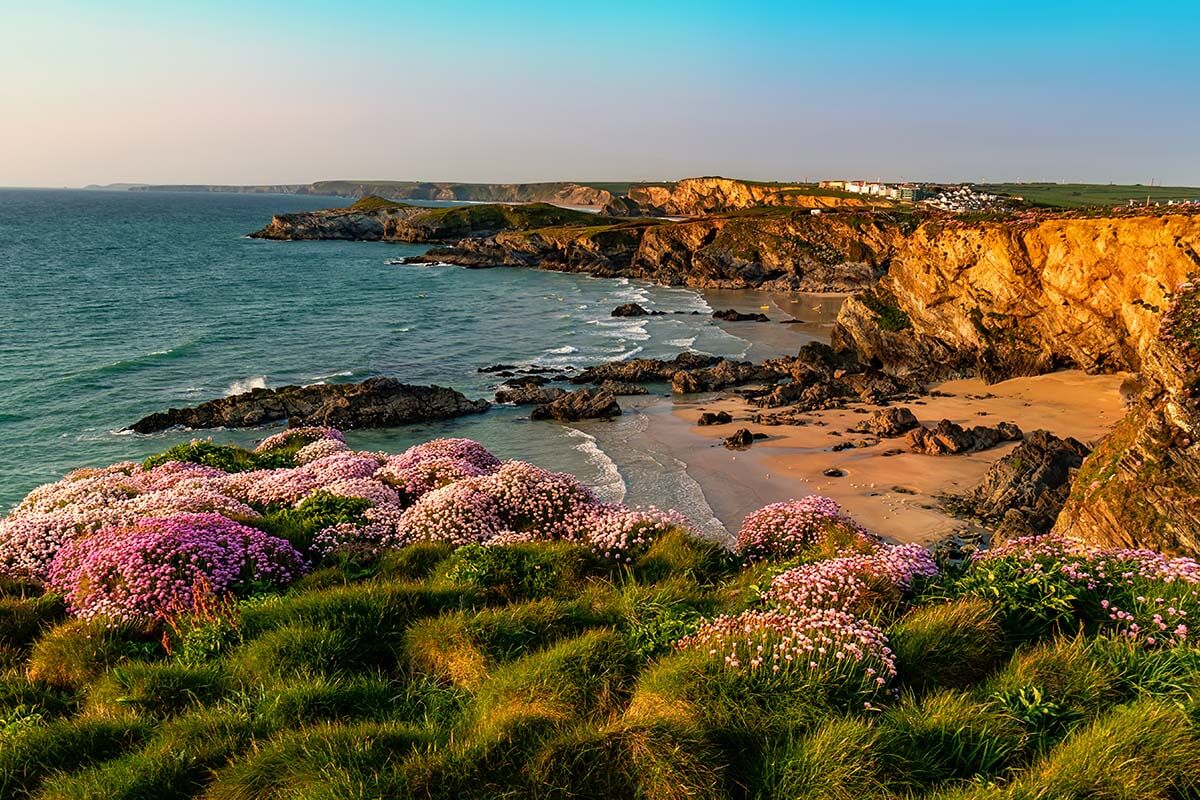
Dotted with pretty villages and offering breathtaking vistas at almost every turn, Cornwall is one of the most picturesque regions of the UK. Located in southwestern England, Cornwall is also home to some of the nicest coastal areas in the country, giving part of the region the name of the English Riviera.
There are so many beautiful places to visit in Cornwall that it can be hard to narrow down your options and choose where to go… So we asked our UK writer, Christine, who recently spent a longer vacation in Cornwall, to give our readers an overview of the very best places to see and things to do in Cornwall .
In this article, she shares her absolute favorite Cornish attractions, which allow you to experience the history, natural beauty, and fascinating culture of this captivating corner of England. Find out!
Good to know: To help you plan your trip to Cornwall, we also created a map indicating all the best Cornwall attractions and nice places to see mentioned in this article. In addition, for every place on our list, we include some practical tips for your visit. At the bottom of this article, you can find more suggestions for nice places to see in Cornwall if you have more time, as well as the best Cornwall tours . Read on!
TIP: If you are looking for hotel recommendations, please see our separate guide to the best places to stay in Cornwall .
How to use this map: Use your computer mouse (or fingers) to zoom in or out. Click on the icons to get more information about each place. Click the arrow on the top left corner for the index. Click the star next to the map’s title to add it to your Google Maps account. To view the saved map on your smartphone or PC, open Google Maps, click the menu and go to ‘Your Places’/’Maps’. If you want to print the map or see it in a bigger window, click on ‘View larger map’ in the top right corner.
Here are the best places to visit in Cornwall:
1. Saint Michael’s Mount
St Michael’s Mount is a unique little island across the water from the town of Marazion. If anything, it could be compared to the famous Mont St Michel in France and is definitely one of the must-see places in Cornwall!
Surrounded by ancient myths and legends, the rocky island is tidal. This means that it’s possible to access St Michael’s Mount by foot via a causeway from Marazion at certain times of the day. At other times, there is an island boat available to take you back and forth.
St Michael’s Mount is most famous for its 12th-century castle, which has been inhabited from 1650 to the current day by the St Aubyn family. But whilst the historic castle is well worth visiting – and affords you wonderful views of Mount’s Bay – there is lots more to explore, including the bustling village, a chapel, quaint eateries, and sub-tropical gardens. In the summer, the 30 live-in islanders sometimes put on special events, such as storytime for children.
How much time do you need: Allow yourself at least half a day, but preferably a full day to see everything the island has to offer. In addition, be sure to allow time to explore Marazion town as well. With its clean sandy beaches and beautiful gardens bursting with rare plants and trees, it’s a nice destination in itself.
TIP: The climb up to the castle is steep and rocky and the island has many cobbled paths with no handrails, so it can be difficult to manage for those with walking difficulties. Sensible shoes are a must!
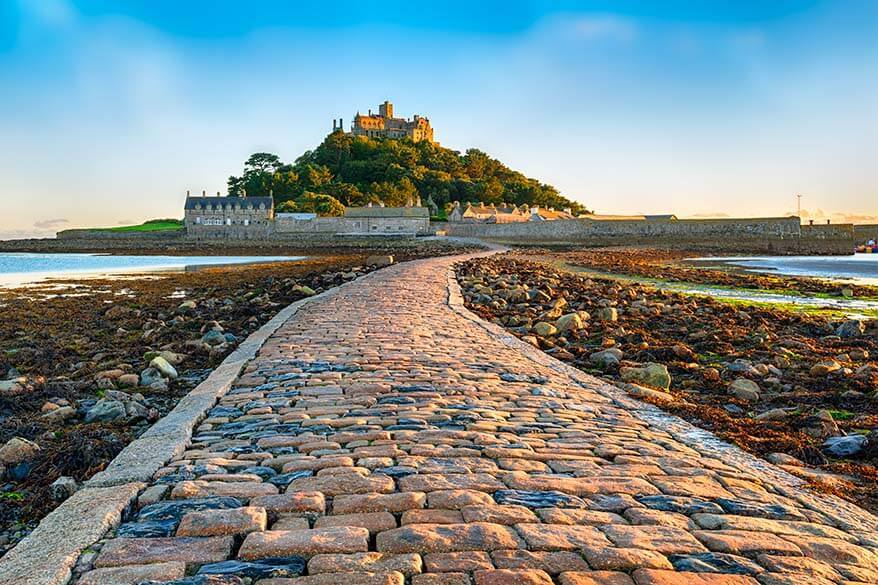
The idyllic town of St Ives is located on a narrow peninsula in the Celtic sea. It has some of the best beaches in the world! In fact, there are four beaches within walking distance of the town, with Porthmeor being especially popular with surfers.
The scenic fishing harbor is surrounded by a maze of quaint, cobbled streets, lined with fisherman’s cottages and local shops. But there is more to St. Ives than its stunning scenery! The town has been home to some of the world’s best sculptors and artists and now has a thriving art scene. Various galleries and studios are dotted throughout the town and St Ives even has its own Tate Gallery on the seafront.
If you are a lover of good food then you will appreciate the world-class dining on offer here, with an emphasis – of course – on freshly caught seafood.
How much time do you need: It’s possible to see the best of St Ives in one day. But it’s worth spending 2 or 3 days to make the most of the beaches, the great shopping, and the town’s numerous museums.
TIP: A great way to appreciate the beauty of St Ives is from the water! You can take a boat trip from St Ives to Seal Island, which will give you great views of the town and the chance to visit the rocky home of a colony of Grey Atlantic Seals.
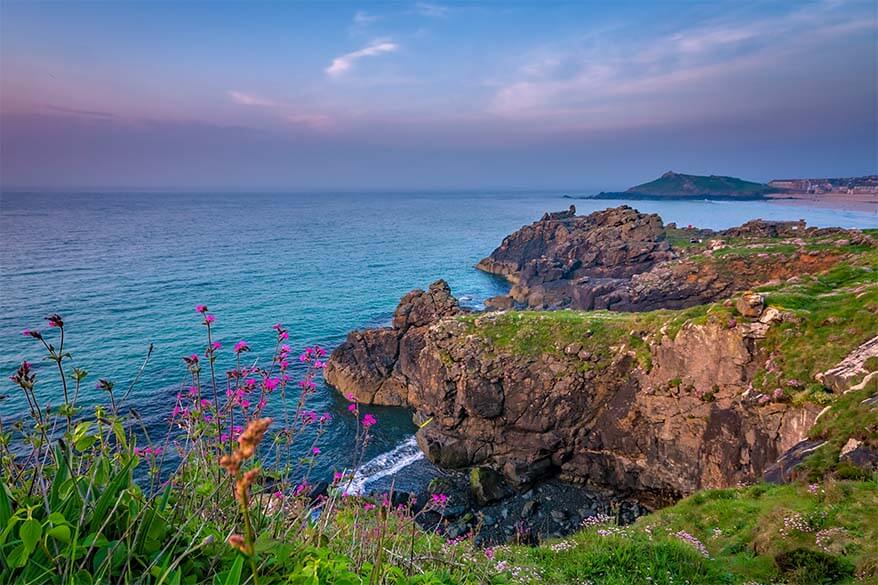
3. Land’s End & Scenic Drive from St Ives
Land’s End is an iconic Cornish attraction, marking Cornwall’s westernmost point and offering breathtaking views of the Atlantic Ocean. It is one of the many places in Cornwall where you can experience nature in all her finery, from the waves crashing against the granite to the wind whipping through your hair as you enjoy rugged clifftop walks.
It is the home of the famous Land’s End sign , which marks the distance to various points including New York and John O’ Groats. Sadly, though, you now have to pay to be photographed standing beneath the sign (although you do get to have it personalized with your family name and the date). The entire area has become heavily commercialized recently, so it does not quite have the wild and rugged feel you may expect in certain areas. Nevertheless, it is still pretty cool to stand at England’s closest point to the US and to admire the awesome view of the Atlantic!
Just driving to Land’s End from St Ives is one of the best things you can do in Cornwall and makes a visit here more than worthwhile! The views along this scenic drive are amazing and there’s a lot to see along the way! Don’t miss Mên-an-Tol – this ancient Bronze Age site has a rare stone with a hole that’s believed to have some magical curing powers!
How much time do you need: Unless you plan to spend time shopping or visiting the small theme park, you really only need an hour or two to see Land’s End. However, in combination with the scenic drive and many nice stops along the way, you could make a nice day trip visiting the area.
TIP: Parking is very expensive At Land’s End. The best option is to park at nearby Sennen Cove instead and walk the one-mile coastal path. You will see a shipwreck along the route and may even spot some dolphins frolicking in the water! Another option is parking at Porthgwarra and walking the 3.6 miles coastal path from there. This will take much longer, but the scenery is amazing as well! Don’t miss Enys Dodnan Arch. But even if you drive straight to Land’s End, be sure to explore (part of) the coastal paths as well!
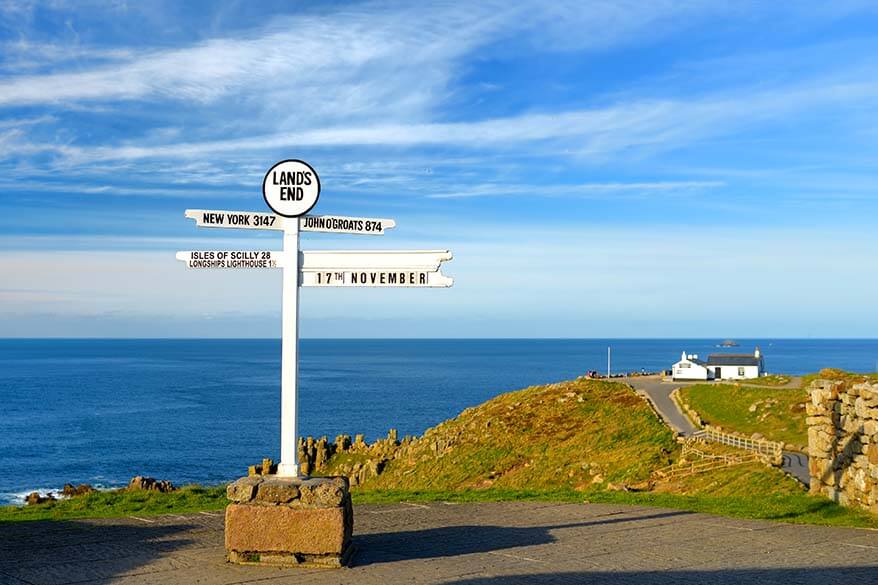
4. The Lizard & Kynance Cove
The Lizard Peninsula on Cornwall’s south coast is the most southerly point of the UK mainland. With only 2 roads in and out, it is largely undeveloped and has some of the most fascinating geology in the country. It’s also teeming with wildlife, particularly bird and marine life. If you’re lucky you can see dolphins, seals, and occasionally even whales!
Lizard is also home to a variety of charming villages and is surrounded by beautiful beaches and secret coves. The most stunning of all is Kynance Cove , on the Lizard’s west side. Accessible via a 2-mile coastal walk, Kynance Cove is one of the most photographed and painted areas in Cornwall. When you visit, you’ll see why!
Pristine white sands contrast beautifully with the reds and greens of the serpentine rock stacks, all set against stunning turquoise waters. When the tide is out, you are free to explore the Cove’s rock pools and caves, with names like ‘The Drawing Room’ and ‘The Parlour’.
How much time do you need: Allow yourself 1 to 2 days to fully explore The Lizard and its many coves.
TIP: Kynance Cove is particularly busy – especially in the summer – so arrive early or visit slightly out of season to avoid the crowds. The descent to the beach is steep and rocky, so wear sensible footwear and be sure to check tide times to make sure that you will be able to safely access the caves.
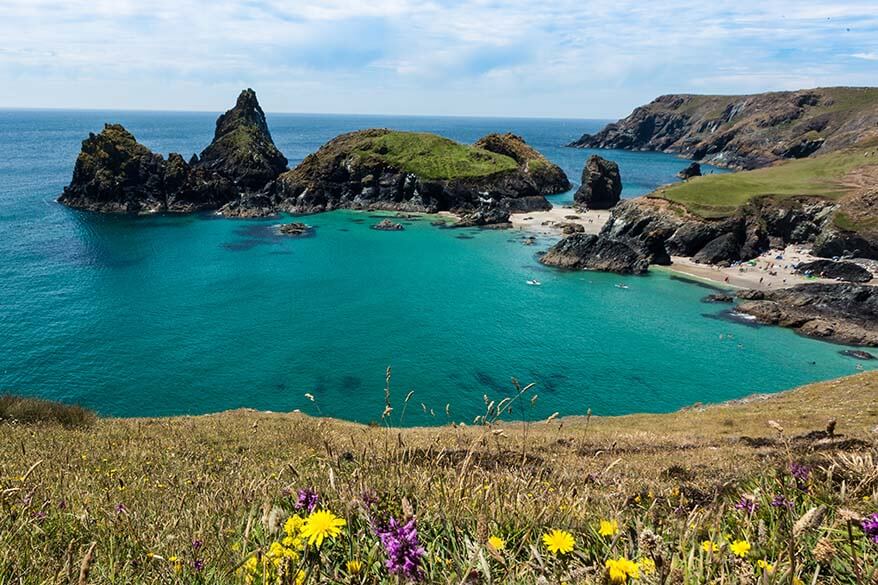
5. Port Isaac
Located on Cornwall’s Atlantic northern coast is the beautiful 14th-century fishing village of Port Isaac . It is everything that you would imagine a traditional Cornish village to be, with slate-fronted white-washed cottages and narrow winding streets, all leading down to the picturesque harbor.
There’s a little something of everything to enjoy in Port Isaac! Many of its buildings are important – either architecturally or historically – and it has several claims to fame. It is the setting for the UK’s popular TV show Doc Martin and has been used as the location for many other TV and film projects. In fact, if you are a Doc Martin fan, you can opt for this popular walking tour of the filming locations !
Port Isaac is still an active fishing port. If you visit in the summer, you can also take fishing trips or scenic boat tours from the harbor.
Designated an Area of Outstanding Beauty and also a Heritage Coast area, there are lots of lovely walks to be had, either along the beach with its numerous rock pools, or further inland. But most popular of all is the village itself, which has lots of charming cafes and restaurants and one of Britain’s narrowest thoroughfares – the aptly named ‘Squeezy Belly Alley’.
How much time do you need: You can easily explore the village in a few hours. If you go walking or take a boat tour, count one day.
TIP: You can get the best views of the harbor from the main car park, which is the first thing you come to as you enter the village. From there it’s quite a steep walk down to the village – which means a steep walk back up! There is a shuttle taxi available, but you might have a long wait at busy times.

6. Porthcurno & The Minack Theatre
Best known for its stunning beaches and the famous The Minack Theatre, Porthcurno is one more of the must-see places in Cornwall.
One of the most popular beaches here is the stunning Porthcurno Beach . This award-winning beach, with its soft white sand and sparkling turquoise waters, is located in western Cornwall, in the corner of Porthcurno Bay. Sheltered by lofty cliffs on either side, Porthcurno Beach is great for families. It is fairly easy to get to via a wide footpath that slopes down gently from the car park above. And it even has its own little stream running along one side, which is perfect for paddling! Fans of the UK’s TV adaptation of Poldark will recognize this beach as the setting for Nampara Cove, where Ross and Demelza were filmed walking hand in hand.
In addition, there are several other lesser-known beaches and stunning coastal paths from where you can enjoy the beautiful surroundings.
Be sure to visit the famous Minack Theatre on the cliffs above. This open-air venue gives you exceptional views of the Bay, right across to the Lizard, and hosts live performances from May to September. When there is no show, you can explore this open-air theatre to the fullest. At the moment, advance bookings are essential; see their website for more information.
The area is also home to the Porthcurno Telegraph Museum , where you can learn all about the important role that Cornwall played in the development of global communications.
How much time do you need: Allow half a day to a day to see all that Porthcurno has to offer.
TIP: Make sure you bring coins with you to pay for parking – the parking machines at Porthcurno Car Park are not equipped for card payments yet. Parking is free in the low season.

7. Tintagel Castle
Tintangel Castle is thought to be the birthplace of King Arthur, the legendary British King. This is also one of the best places to visit in Cornwall – with a wonderful location set high on the cliffs of the rugged North Cornwall coast. The views are great, the ruins are fun to explore, and a visit here is fun for the whole family!
Since recently, the two parts of the castle that are set on different cliffs have been reconnected by Tintagel Castle Bridge . A walk on this impressive bridge not only gives you the chance to experience the area as it was in medieval times but also offers some amazing views of the coastline.
Don’t miss King Arthur’s Statue and also the little beach below the castle and Merlin’s Cave , one of Tintagel’s best-kept secrets. The walk down is quite steep, but they also have a ‘shuttle’ that can bring you down and up.
TIP: Before you visit the castle, head to King Arthur’s Great Halls in Tintagel. It’s a great place to learn more about the legend of King Arthur and his Knights of the round table. Open from March to October.
How much time do you need: Count at least 2-3 hours for a visit to the castle, but you can easily spend more than half a day here. For more information and opening times, please see their website .
Good to know: Prepare for lots of walking. Sensible shoes are a must. It can also be quite windy here, so dress warm.
TIP: St Nectan’s Glen Waterfalls nearby are also worth a visit.
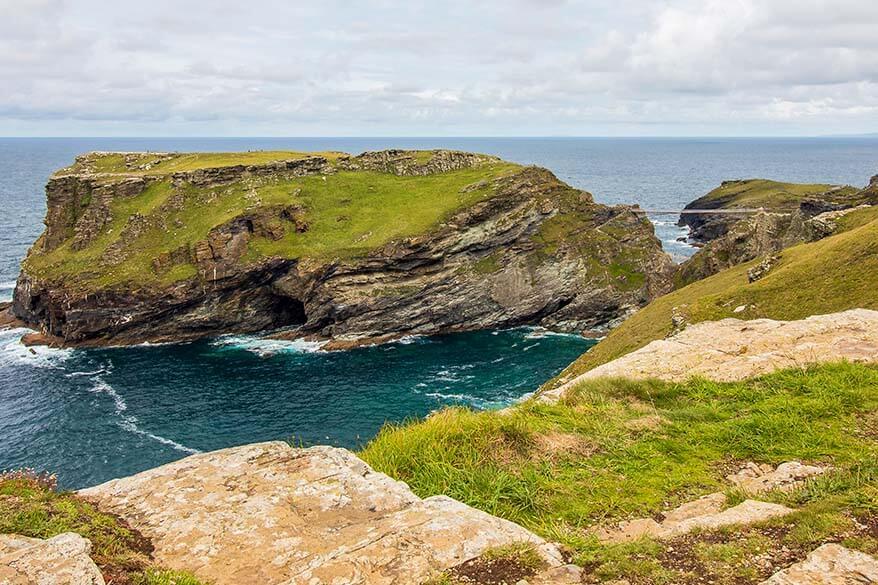
8. Polperro
With so many beautiful spots all over Cornwall, it can be hard to pick the most picturesque. Nevertheless, most visitors to Polperro will agree that it is one of the prettiest villages in the county. Its quaint fisherman’s cottages and traffic-free, winding streets are set along the sides of a cliff ravine on Cornwall’s south coast.
The village is centered around a peaceful fishing cove filled with colorful boats. The area has a rich history of shipwrecks and smuggling and you can see fascinating features in the village, including Roman and Saxon bridges.
Polperro has a small sandy beach and its own tidal sea pool which you can access via a steep climb down the cliff if you’re feeling adventurous. The best view of the village is definitely from the water and you can easily arrange either a pleasure cruise or a fishing cruise directly from the quay. If you’re traveling with children, don’t miss the Museum of Smuggling (aka Harbour Museum ) and the Polperro Model Village with its very own model railway.
How much time do you need: Plan to spend a full day in Polperro. This will give you time to visit the main attractions, take a cruise, and enjoy the delicious local food available at the village’s eateries.
TIP: Polperro hosts lots of seasonal events, so be sure to check ahead if there are any that might coincide with your visit. One of the most popular is the Music and Arts Festival in June, which includes a colorful carnival and the lighting of the solstice bonfire.

The North Cornwall fishing port of Padstow has lots to offer its visitors! Most popular of all is the harbor itself, bustling with people and a great place to watch the world go by. There is a variety of great boat tours here. So whether you want to do a little sightseeing from the water, catch some fish, or get a better view of the area’s varied marine and birdlife, you will find a boat tour to suit.
One of Padstow’s most popular features is the stunning Camel Trail . 17 miles long and following the course of the River Camel along the route of the former North Cornwall Railway, the Camel Trail gives you the perfect opportunity to cycle through some of the most beautiful scenery in the county. There are no steep inclines and the Trail meets virtually no traffic, so it is ideal for the whole family.
Whilst in Padstow, be sure to hop aboard the Black Tor Ferry and take the 5 minute trip to Rock . Holiday spot for the Royals, it’s a favorite with the rich and famous and has even been dubbed Britain’s Saint-Tropez!
How much time do you need: Allow 1 to 2 days, particularly if you plan to cycle the Trail (you can rent a bicycle in Padstow for the day).
TIP: Celebrity chef Rick Stein has a restaurant, cafe, and several shops in Padstow. His specialty is seafood, so a fish and chip dinner at his restaurant is a treat not to be missed!
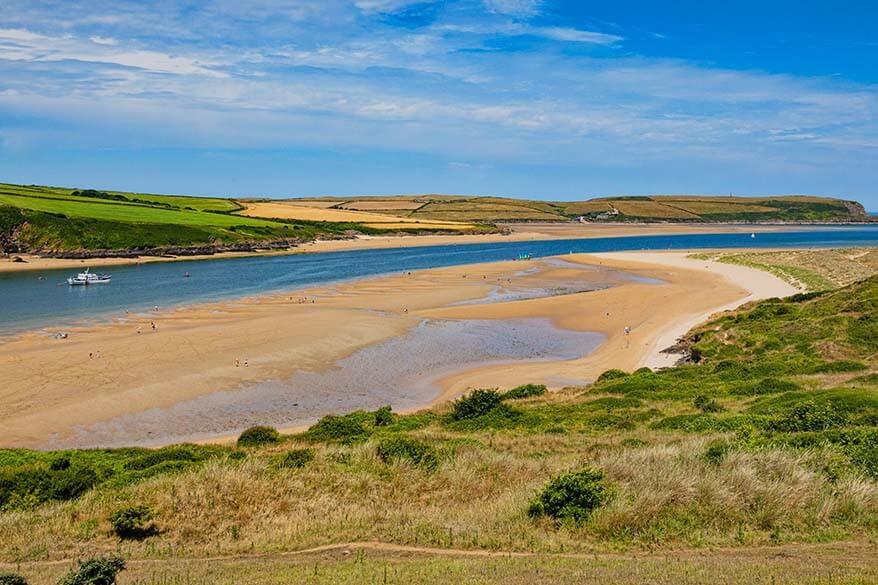
10. St. Austell, Mevagissey & The Lost Gardens of Heligan
St. Austell is Cornwall’s largest town, and whilst the town itself has few attractions, it makes a great base from which to visit the nearby fishing village of Mevagissey .
In a county dotted with beautiful fishing villages, Mevagissey is considered by many to be the loveliest of them all! Brightly colored houses nestle against the steep hillside, whilst the waters of the harbor are shallow and turquoise.
Just 15 minutes by road from the center of St. Austell are the Lost Gardens of Heligan , so named because they were hidden by brambles from the end of the First World War, all the way up to 1990 when they were rediscovered. Spread over 200 acres, this is Europe’s largest garden restoration project. It includes four beautiful walled gardens, along with the incredible living sculpture the Mud Maid. The Lost Gardens of Heligan have an other-wordly feel to them and it’s easy to spend a few hours exploring all the different zones and woodland. For opening times and practical info, please check their website .
How much time do you need: Allow 1-2 days to see Mevagissey and the Lost Gardens of Heligan. If you have time, it’s also worth visiting St. Austell’s main port, Charlestown, where you will often spot old sailing ships.
TIP: As you enter St. Austell, be sure to look out for the ‘ Cornish Alps ‘ surrounding it. These strange, conical white-topped mounds are actually products of the area’s china clay pits, which were the backbone of St. Austell’s industry for many years.

11. Eden Project
Did you know that Cornwall is home to the 8th wonder of the world? Well, that may not be officially true, but nevertheless, it’s a compliment often paid to the ambitious Eden Project in Bodelva, just a few miles from St. Austell!
This vast attraction could probably be best described as a sort of botanical garden, but it’s so much more than that! It houses the world’s largest captive rainforest in a magnificent ‘biome’. Here, you can experience tropical sights and smells and even take a walk on a canopy walkway above the treetops! Although the Rainforest Biome is the Eden Project’s largest and most popular feature, there is lots more to see and do here. The 30-acre Outdoor Garden is filled with bobbing sunflowers and a second biome focuses on the Mediterranean and all of its fabulous flora.
The purpose of the Eden Project is mainly educational – for children and adults alike. There are various workshops aimed at all age groups, along with the opportunity to learn about the relationship between the plant world and mankind. Kids in particular will enjoy learning about the tropical plants that are used to produce some of the objects they see and use every day!
How much time do you need: Aim to spend a full day here. There is plenty to see and do and there are some nice cafes where you can get lunch or snacks.
TIP: The Project is quite expensive to visit. So to make the most of your day, try to visit in good weather, which will allow you to enjoy the outdoor exhibits as much as the indoor ones. Don’t forget your sunscreen, as there is little sun protection anywhere. For practical info and opening times, please see their website .

12. Falmouth
Located in a sheltered bay on Cornwall’s south coast, Falmouth was recently named Britain’s best coastal town. Perfect for exploring on foot, Falmouth is divided into two sides. On one side you can see the lovely working harbor and docks. You can learn more about them in the 12 galleries of the town’s impressive National Maritime Museum . On the other side, you’ll find two stunning sandy beaches. The best for swimming (and closest to town) is Gyllngvase Beach , with its powdery soft sand and clear waters.
The two sides of Falmouth are divided by a grassy headland, on which sits the Pendennis Castle , built by King Henry VIII in the 16th century. As you stroll through town admiring the old architecture, look out for Jacobs Ladder . This 111 step granite stairway leads up from the Moor – Falmouth’s main square. It may sound Biblical, but it was actually named after the local businessman who built it as a shortcut between his home and his business premises.
How much time do you need: Allow one full day to explore Falmouth.
TIP: Falmouth regularly hosts festivals, celebrating everything from oysters to beer! See if you can plan your visit to coincide with a festival based around something you enjoy!
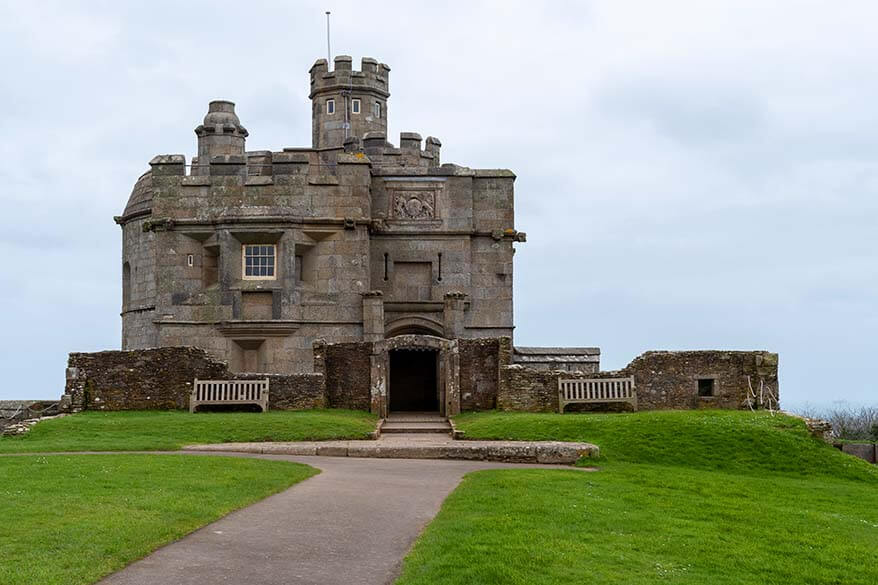
Whilst Cornwall’s coastal resorts tend to be among the most popular, an area not to be missed – Bodmin – is several miles inland. Formerly the county town of Cornwall, Bodmin is steeped in history and there are lots of interesting buildings to explore, including a 15th-century church, two museums, and gorgeous stately homes.
Head to the town center to hop aboard a steam train at the Great Western Railway Station at Bodmin Central. This is a great way to explore the surrounding area! You can also take a trip back in time and learn more about the town’s sinister history of crime and punishment with a tour of its courtrooms and the notorious Bodmin Jail , the site of numerous public hangings.
Aside from its historic interest, the area east of Bodmin – known as Bodmin Moor – is a designated Area of Natural Beauty. With miles of walking trails, this remote and sweeping moor is dotted with high granite boulders, ancient oak trees, and fascinating stone circles. It is easy to see why the novelist Daphne du Maurier was so inspired by this landscape! After a walk on the moor, you can enjoy a pint at the Jamaica Inn, which was immortalized in her novel of the same name.
Also the nearby Lanhydrock estate with an impressive Victorian country house and gardens is well worth visiting here!
How much time do you need: You could easily spend 2 full days exploring Bodmin town and the natural beauty of the local area. If you just visit the main attractions in town, count half a day.
TIP: It is well worth staying in the area overnight. Bodmin Moor was awarded Dark Sky Landscape status because of its efforts to reduce light pollution. This means that its exceptionally dark skies offer excellent opportunities for stargazing!
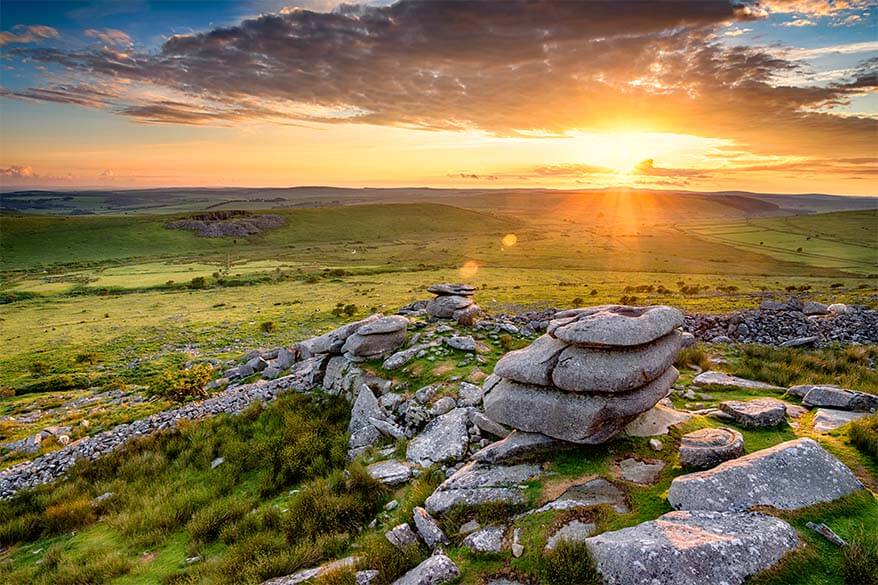
14. Fistral Beach, Newquay
Located on Cornwall’s north coast, Newquay is one of the county’s most popular seaside towns. But what makes it extra special is its amazing Fistral Beach ! This straight, sandy beach is over 800 yards long, with high cliffs behind it, rolling dunes, and numerous rock pools perfect for crabbing.
Fistral Beach’s main attraction, though, is its surf! Bounded by two headlands, powerful waves are funneled into the west-facing beach, making Fistral one of the top surfing destinations in the world. If you want to indulge in a spot of surfing yourself, there are lots of places to hire equipment. And if learning to surf has always been on your bucket list, you can even book lessons here.
If you’re feeling less energetic, then it’s very easy (and lots of fun) to while away the hours just watching other people tackle the waves. The beach has wonderful facilities including a very good restaurant and cafe, along with a great atmosphere for the whole family to enjoy.
How much time do you need: You can easily spend anything from a few hours to a whole day here.
TIP: Although the beach is monitored by lifeguards, do check the tide times carefully as it is possible to be cut off from the main part of the beach when the tide comes in.
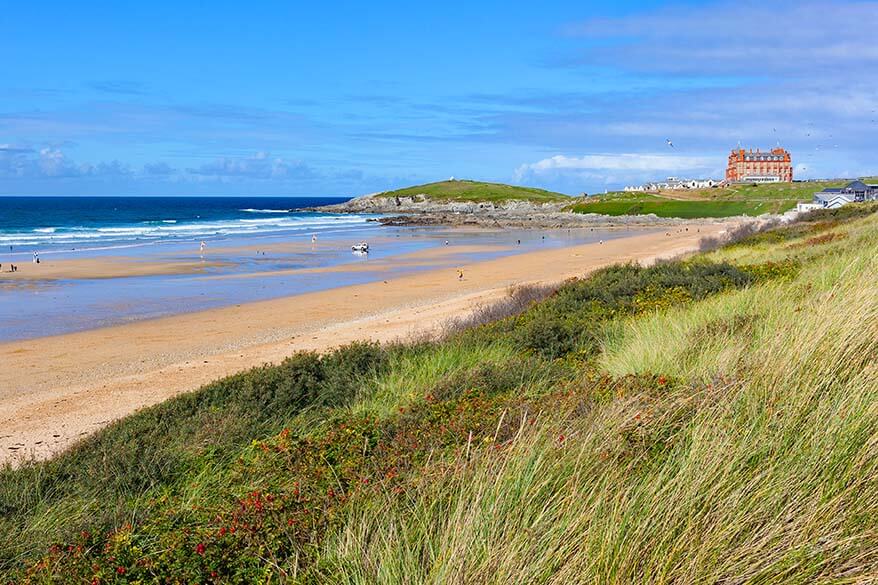
15. Mousehole
No visit to Cornwall would be complete without a visit to the charmingly named village of Mousehole on the south coast. No one is quite sure where the name actually came from, although some say it is connected to the huge cave located a few hundred yards along the coast.
Mousehole has rather a sad history – the village was completely burnt to the ground during the Anglo-Spanish War in 1595 and just one building survived. That building is now the Keigwin Arms pub, which has undergone quite a bit of restoration since!
The quaint village has narrow, winding streets with plenty of independent shops, galleries, and eateries, with many of the pretty cottages built from local Lamorna granite. One of the nicest features in Mousehole is its beach! Located in the sheltered part of the harbor, it is small, safe, and absolutely perfect for families with younger children. If you have time, be sure to take a walk along the coastal path to Lamorna – an absolutely stunning little cove at the end of a verdant valley, complete with a babbling stream!
How much time do you need: Allow half a day to a day for a relaxing visit here.
TIP: If visiting Mousehole by car, park on the outskirts and walk in. Parking on the narrow streets is very difficult. Better still, take a bus to the village from Penzance.
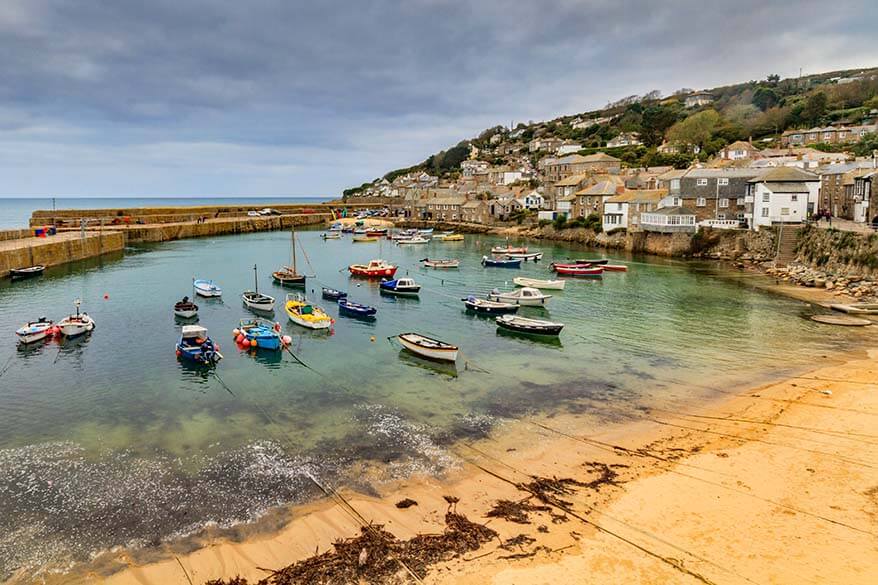
16. Cornwall Coast Path from Hartland Quay to Bude
While Hartland Devon Heritage Coast isn’t officially in Cornwall, it’s just at the county border. The coastal walk from Hartland Quay (in Devon) to Bude (in Cornwall) is well worth considering if you are looking for something nice to do in Cornwall a bit off the beaten path.
While the entire walk is quite strenuous and 15 miles long, you can also just walk a small part of the trail, e.g. up to Speke’s Mill Mouth Waterfall . Starting in Hartland Quay, head south along the Cornwall Coastal Path. The waterfall is just about 1 mile (20-30 min) walk and is well worth it.
This area is off the beaten path and much less visited than most other Cornwall attractions mentioned in this guide. If you are looking for nice coastal scenery without the crowds, check it out!
TIP: If you drive all the way to Hartland anyway, check out the Hartland Abbey as well!

More nice places to see in Cornwall
In addition to the most popular sights and Cornwall attractions mentioned above, there is so much more to see and do in this beautiful corner of England. Here are some more nice places to see in Cornwall if you have more time:
- National Trust – Trelissick Garden
- National Trust – Lanhydrock
- National Trust – Godrevy
- Helford Passage
- St Mawes Castle
- Trebah Garden
- Flambards Theme Park
As you can see, there is plenty to see and do in Cornwall to fill a few vacations. But if you are looking for the very best places, this list should help you see the best that the region has to offer.
Cornwall Tours
If you are looking for some nice Cornwall tours, here are some of the very best options:
- 1 day in Cornwall: West Cornwall Tour . This tour brings you to St. Michael’s Mount, Land’s End, and several other top spots.
- 2 days in Cornwall: King Arthur Tintagel and Boscastle Tour . This tour visits Tintagel Castle and the area around it, in combination with several other beautiful places in this area.
- 5 days Cornwall & Devon tour from London . Devon & Cornwall tour . This is the most popular tour of southern England. You get to see some of the main highlights of Cornwall and so many other beautiful places. Check it out!
READ ALSO: Where to Stay in Cornwall – best towns & hotels for every vacation and every budget
More travel tips and inspiration for the UK:
- Cities: Best Cities to Visit in the UK
- Must-see in London: Top London Attractions & 1 Day in London & 2 Days London Itinerary
- Different London : Hidden Gems of London & Best Views in London
- Good to know: London Travel Tips & Best Areas to Stay in London
- Near London: Best Day Trips from London for Sightseeing
- With kids: London with Kids & Family-friendly Afternoon Tea in London
- Greenwich: Best Things to Do in Greenwich & Painted Hall
- Food: British Food: Dishes to Try in the UK
- Yorkshire: Yorkshire Day Trips
- Manchester: Best Things to Do in Manchester & 1 Day in Manchester
- Liverpool: Best Things to Do in Liverpool & Day Trip from London to Liverpool & The Beatles Liverpool
- Scotland: Isle of Skye & Scotland Whisky Tour
- Edinburgh: Top Edinburgh Attractions & One Day in Edinburgh
- Glasgow: One Day in Glasgow
- Seaside: Best Things to Do in Blackpool & Tips for Visiting Blackpool
If you found this post helpful, don’t forget to bookmark it and share it with your friends. Are you on Pinterest? Pin these images!
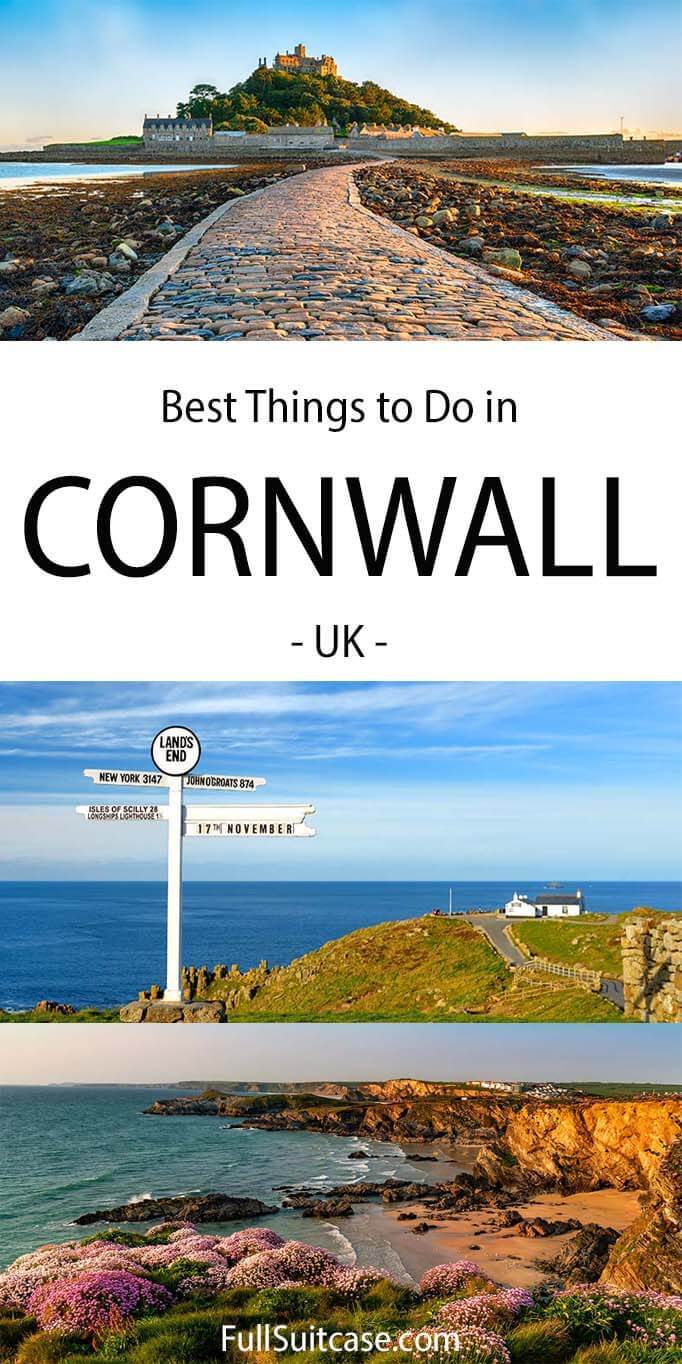
This site uses Akismet to reduce spam. Learn how your comment data is processed .
Dr david wood
Friday 21st of October 2022
I i like cornwall ? But i am stilling looking for unique experience its finding a restful hotel great food
Saturday 22nd of October 2022
Hi, I'm not quite sure I understand your question. Are you looking for a nice quiet hotel and good food? I'm sure that many hotels can offer that.
Sunday 16th of May 2021
Thank you for your lovely post. We will be local travellers also, so I will enjoy looking at your posts!!
Wednesday 19th of May 2021
Thanks for reading and enjoy exploring England this summer, Linda! There are so many nice places to see - a great place for local travel this year! :)
The top 21 things you can't miss on your next Cornwall vacation

Jul 7, 2022 • 14 min read
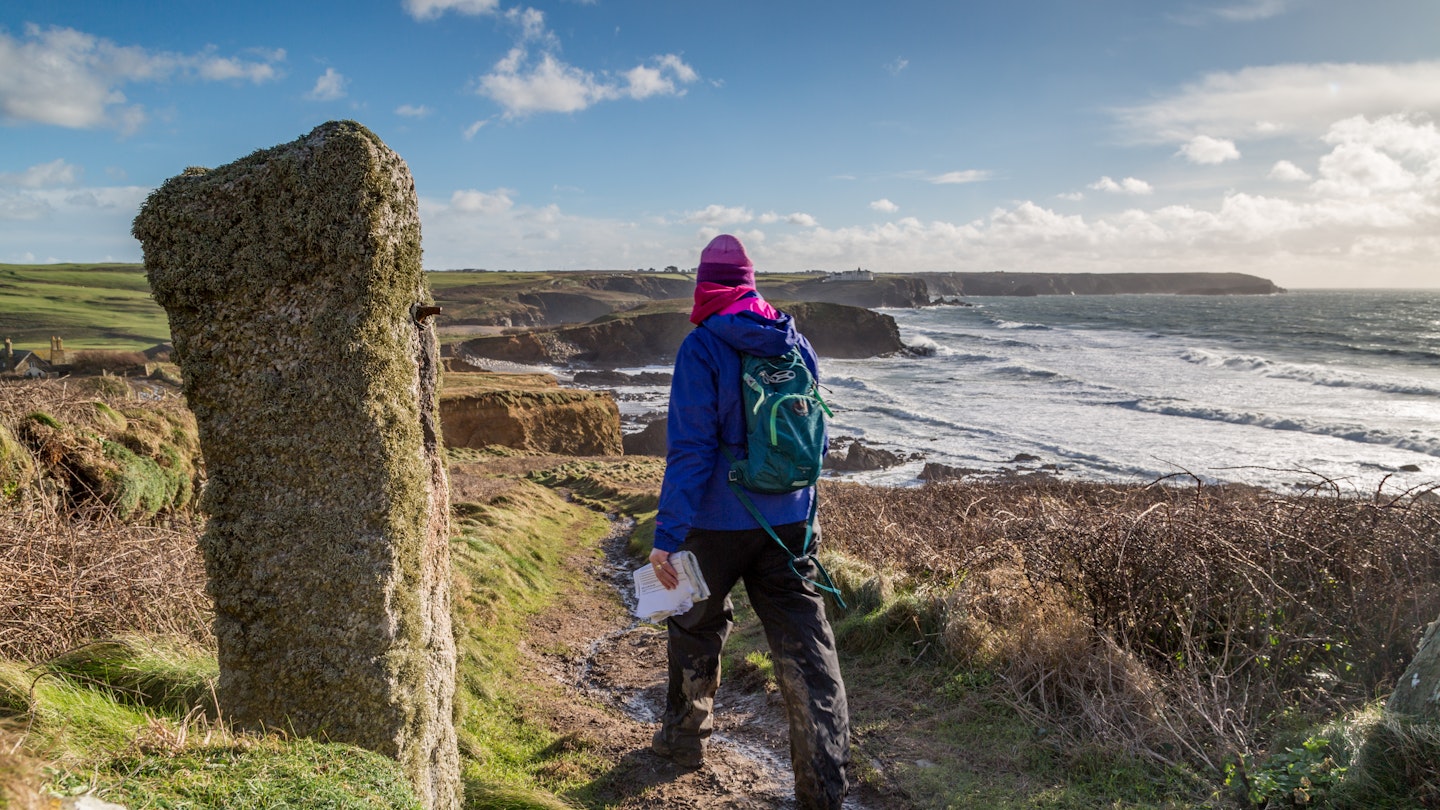
Hiker walking a section of the 630-mile South West Coast Path in Cornwall © Paul Nash / Shutterstock
Expansive beaches, chic hotels and moody Poldark filming locations – it seems picturesque Cornwall is rarely off British TV screens. But while the county is awash with sandy beaches and quaint pubs, there’s also a much richer narrative to explore.
This one sees you seaweed foraging, vineyard visiting, barefoot beach combing, or soaking in an open-air geothermally heated pool. Time to star in truly awesome adventures of your own with our pick of the best things to do in Cornwall.
Go for a gorgeous geothermal soak
Although Cornwall has some of Britain’s warmest seas an outdoor swim can still feel a decidedly chilly affair. Enter Penzance’s art deco, open-air Jubilee Pool . This triangular 1930s saltwater lido sits right beside the sea, a geometric vision in blue and white. But what makes it a sensational swim spot is the geothermal section. It’s heated to a blissful 30 to 35°C (86-95°F) by water that’s been extracted from a geothermal well that plunges 410m into the ground . It’s not only an unforgettable place to float, it’s sustainable too as the whole heating process has a tiny carbon footprint. Geothermal tickets sell out fast: book well in advance.

Eat in an authentic pub
Cornwall is home to lush scenes on TV screens but visitors can be surprised to find not everywhere is picture-perfect. Cornwall is one of Britain and Europe’s poorest regions , due to a decline in traditional industries, lower than average wages, high house prices and a seasonal gig economy . Time then to support the fishing industry, back a brilliant chef and have a fantastic meal at the same time. The Tolcarne Inn sits beside the harbor wall in the decidedly gritty port of Newlyn. Here chef Ben Tunnicliffe has created a superb, unpretentious dining experience in a welcoming, cozy, historic pub. Opt for whatever’s come in on the day boats – it’s sustainable and has been landed just yards away.

Walk the causeway to St Michael’s Mount
A rocky, tidal island topped with an ancient castle and steeped with Cornish folklore, St Michael’s Mount is one of the most famous places to visit in Cornwall. But this popularity makes it no less magical.
The causeway connecting the island to the mainland is only exposed at low tide, so you’ll need to time your visit carefully. Pilgrims have been making this same crossing for centuries in homage to the island’s namesake, the patron saint of fishers. As you make the climb up to the castle, look out for the heart-shaped stone set into the cobbled path. Local legend holds that this is the heart of the giant Cormoran, slain by Jack the Giant Killer.
Unearth the real stories behind those photogenic mines
Poldark – the BBC TV series (also on Netflix) of life, love and tragedy in 18th century Cornwall – remains a huge visitor attraction in the region. But while many head to the filming location of ruined Botallack Mine to snap a selfie, more powerful narratives can be explored at Levant Mine , a few miles north. Here you can see the world’s only still-working steam beam engine thundering away and head into the Man Engine tunnel. This was the scene of Cornwall’s worst-ever mining tragedy, where 31 men were killed when a transport system collapsed in 1919 . Watching Poldark will never seem quite the same again.
Surf the North Cornish Coast
Cornwall has become a world-famous surfing destination, particularly on the north coast, where Newquay’s Fistral Beach is known as the “Home of British Surfing.” Whether you’re a keen enthusiast or an absolute beginner, taking to the waves in Cornwall is a must.
Beginners can book into a surf school in Newquay, or head to gentler spots like Polzeath Beach or Harlyn Bay . More experienced surfers might enjoy the challenge of Porthleven’s reef break , or, in winter, the cove at St Agnes . Don’t fancy big waves? Try stand-up paddleboarding (SUP) at Polkerris Beach or Falmouth’s beloved Gylly Beach instead.
Sample Cornish wines besides the vines
While foodies head to Cornwall’s harborside restaurants, wine lovers go inland – the county is one of the best places to sample superb local vintages in the UK. The wine produced at Camel Valley is some of Britain’s best; under winemaker Sam Lindo, Camel Valley’s fizz has beaten French Champagne house, Bollinger, in global awards. Camel Valley is also a beautiful site to visit – rows of vines etch sun-soaked slopes on the edge of Bodmin Moor. Book ahead for a guided tour or arrange to sip chilled wine by the glass on their vine-side sun terrace .

Catch the eco bug and a concert at Eden
The pioneering eco attraction that is the Eden Project tops many visitors’ lists of things to do. Famously built in an abandoned China clay pit, this cluster of gigantic geometric greenhouses is home to massive biomes that recreate two key world climate systems. The Mediterranean biome transports you to temperatures of 9 to 25°C (48-77°F) and the fruits, herbs and flowers of Italy, Greece and Spain. Here you’re surrounded by bougainvillea, cotton, aloes, olive trees and vines (no surprise that many people visit Eden when it rains).
In the Rainforest biome, you’ll feel temperatures rise to 18 to 35°C (64-95°F) as you stroll beside rubber tree groves, sugar cane plantations and banana trees. You can even walk on a swaying wooden bridge, suspended high in the canopy. The biome also explores issues surrounding palm oil and deforestation. Everywhere at Eden, artwork and imaginative displays outline environmental issues and nudge us towards a greener, clearer future. But the best way to see Eden is during one of the legendary Eden Sessions – a series of summer music concerts that have showcased artists from Tom Jones and Kylie Minogue to Paloma Faith, Oasis, Elbow and Muse – tickets include a day-pass to the wider site.
Follow the King Arthur Trail to Tintagel
Powerful wizards, noble heroes, a sword trapped in stone… here, there be legends. Whether he was a romantic myth or a real-life mortal, King Arthur has become very much a part of the fabric of Southwest England’s story. And that story was born in North Cornwall .
Follow the King Arthur Trail through these legendary landscapes to live the myth at places like Camelford, thought to be the site of Camelot, where a 6th-century stone inscribed in Latin supposedly marks the site of Arthur’s final battle with his traitorous nephew Mordred.
Although the castle we see today was built in the 1230s, Tintagel was a seat of Cornish kings since the 5th century BCE, among them King Arthur. So says the legend, at least. Cross the narrow bridge to reach the eerie ruins on their jagged headland, before heading down to the sheltered bay below to explore Merlin’s Cave.
Take a "stank" on Bodmin Moor
Cornwall’s coastal paths are well-known, but inland there is plenty to entice walkers, too. Take a “stank” (local dialect for “walk”) on Bodmin Moor – a remote, heather-strewn moorland whose bleak but beautiful landscapes provide the perfect setting for adventure.
Soak up the views from atop Brown Willy, the highest point in Cornwall and one of the UK's best hikes , or explore the stone circles and bronze age barrows surrounding the slopes of Rough Tor. Fans of Cornwall’s most famous author, Daphne du Maurier, won’t want to miss the real-life Jamaica Inn at the heart of the moor. As in the novel, this isolated inn was once used to stash smuggler’s contraband in the late 18th century.
Cook a Cornish pasty
The Cornish pasty – beloved by 17th-century miners, claimed to be worth £65 million to the Cornish economy, and awarded protected status (only pasties made in Cornwall can use the geographic name). Buy them everywhere from rugby grounds and surfer hangouts to old-fashioned village stores. Or go one better and learn to make them yourself. The pasty-making course run by the Philleigh Way Cornish Cookery School near Falmouth sees you learning about the delicacy’s history and culture and practicing essential techniques, including the famous crimp. A demo on homemade scones and a Cornish cream tea is thrown in while your pasties bake – gifting you two Cornish culinary icons in one session.
Explore the Cornish mainland’s second-most westerly point
The problem with travelers’ totems is that sometimes they get overrun. At Cornwall’s most westerly mainland location, Land’s End , the dramatic cliffs are crowned by a theme park complete with a hotel, pub and 4D cinema. Time to head 7 miles north to the rugged headland at Cape Cornwall . Here you’ll discover a real end-of-the-world feel, a ruined early-Christian chapel, a derelict mine stack and tiny Priest's Cove which – at low tide – has a pocket-sized pool. Until about 200 years ago, the Cape was actually thought to be the most westerly point in mainland Cornwall then it lost that title to Land’s End. It’s a lot quieter than that other headland now.
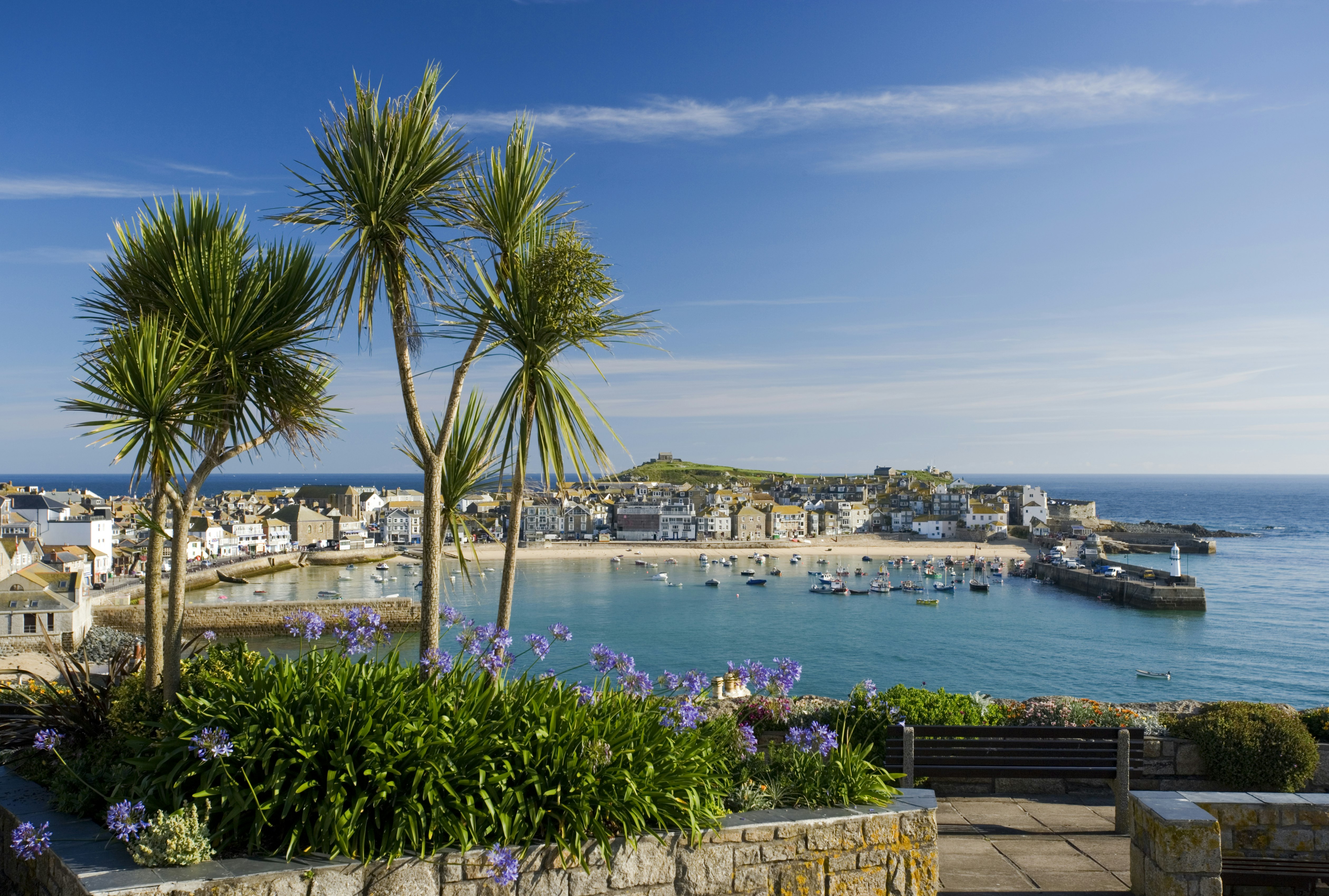
Discover Cornwall’s forgotten corner
Most of the cars whizzing west into Cornwall cross the county border and carry straight on. But if you turn south instead, you enter the much-overlooked Rame Peninsula . It’s home to three-mile Whitsand Bay , the pretty fishing villages of Kingsand and Cawsand , and Rame Head – a rocky promontory that juts into the sea providing 360-degree views east to south Devon and west to the Lizard peninsula, some 50 miles away. To get a true taste of the area’s wild beauty, walk to Whitsand Bay from Mount Edgcumbe Country Park – a 10-mile cliff path hike via Kingsand, Cawsand and Rame Head that has exceptional views.
Catch a show at the Minack Theatre
Chief among Cornwall’s cultural highlights, the Minack Theatre is an open-air theater in an unbeatable location. Perched on a clifftop near Penzance , this spectacular setting looks as though it has always been there, its stone seats facing out onto the Atlantic Ocean.
In actual fact, the Minack is less than 100 years old. It was built in the 1930s by Rowena Cade, who felt her cliff garden would be the perfect setting for a performance of The Tempest . Today, over 200 live performances a year grace this unique stage, from plays and operas to children’s events.
Paddle off on a sea kayaking expedition
Supremely scenic from the land, Cornwall’s coast and rivers are spectacular when explored by kayak. Gin-clear seas, towering cliffs, tree-lined creeks, otherwise inaccessible coves. To really get immersed in the experience, sign up for a five-day sea kayaking trip with Evoke Adventure . Run by international expeditioner, Erin Bastian, the Best of Cornwall adventure sees you exploring the coast and estuaries near Falmouth – opening up everything from gliding up the sheltered waters of the bewitching Helford Passage to paddling beneath the exposed cliffs of the Lizard peninsula. It’s an unforgettable way to explore.
Forage for your food
Cornwall’s wide sea views draw your eyes to the horizon, but there’s much to be gained from zooming in. The Family Foraging Kitchen has you studying the shores, hedges, fields and woods in front of you. Courses take place on the Rame Peninsula – their seaweed foraging courses are held on golden beaches beside the broad sweep of Kingsand Bay. Each course covers local history, science and folklore as well as ethical foraging, species identification and how to cook what you find. By booking a session you’re also supporting a good cause – the kitchen helps combat food poverty by providing free wild food education to local families in need.
Spot naïve art in St Ives
The clear light and picturesque scenery of Cornwall have long drawn artists – from the impressionists of the Newlyn School of the 1880s to the abstract artists of the St Ives School in the 1940s. The local creative heritage was a factor in one of Britain’s most prestigious art institutions, the Tate , opening a beach-side outpost in St Ives in 1993.
Among the wealth of works, hunt out pieces by St Ives resident Alfred Wallis . A retired fisherman, he was entirely self taught. Working at his kitchen table, he used marine paints on bits of cardboard boxes to capture quintessentially Cornish scenes. His unaffected, instinctive style chimed with artists wanting a fresh approach after the horrors of WWI and he later became lauded for creating evocative naïve folk art. Head for the gallery’s ongoing Modern Conversations display and hunt out Wallis’ Schooner under the Moon and The Hold House Port Mear Square Island Port Mear Beach – then stroll outside onto Porthmeor Beach itself and look for the similarities between Wallis’ work and the scene today.
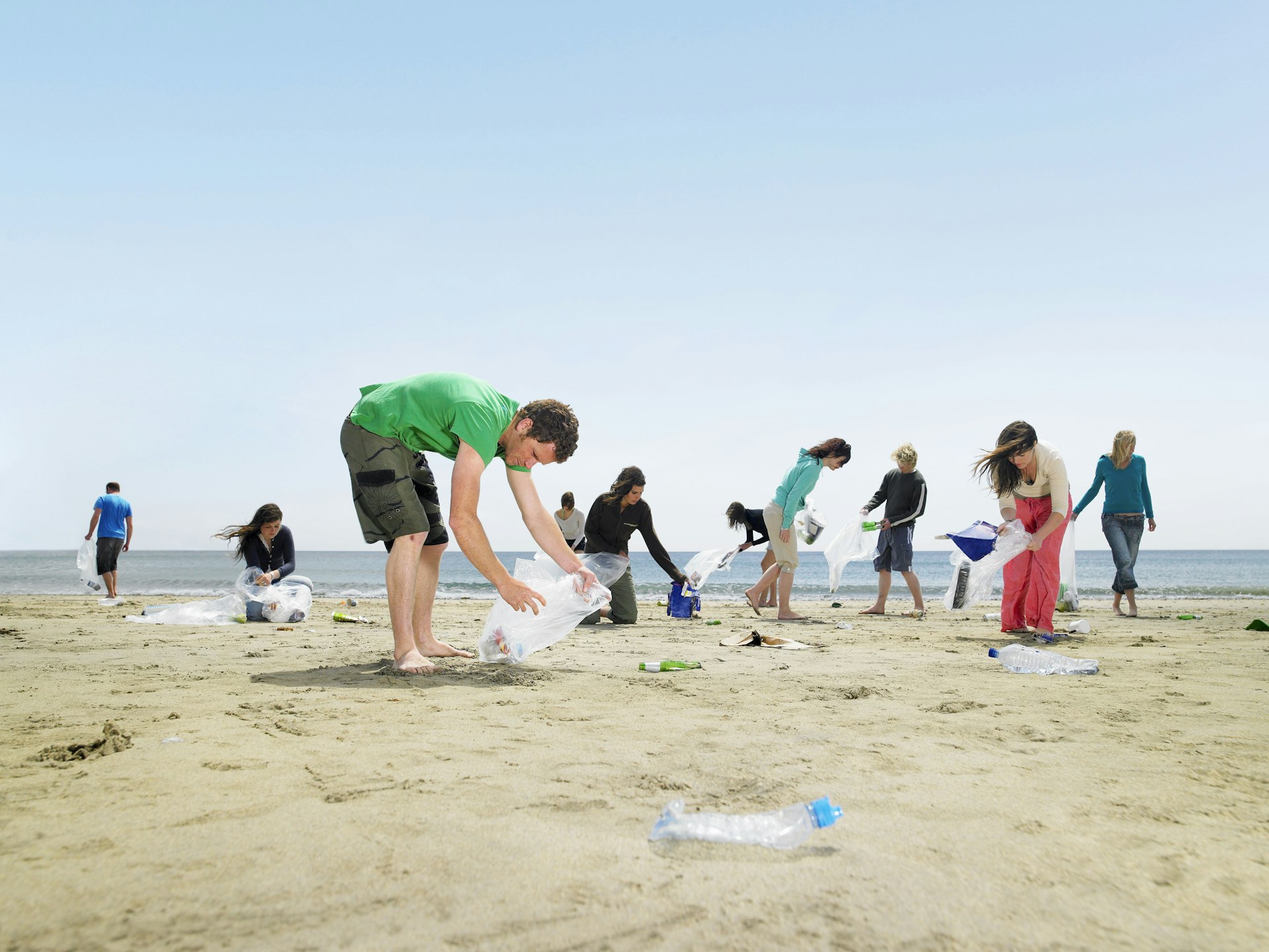
Give a little back with a beach clean
While Cornwall’s beaches are genuinely gorgeous, they’re as hit by plastic pollution as any others around the world. Cornish environmental charity Surfers Against Sewage began campaigning to clean up seas in 1990 but now cites plastic as the new sewage. As well as backing organized coastal litter picks and inspiring people to stage their own , the charity also has a map of Cornish beach boxes where you can stash any trash you’ve collected. An ideal opportunity to explore Cornwall’s endless beaches and do good deeds for the environment at the same time.
Blast across Falmouth Harbour by boat
Cornwall’s shoreline is a string of beautiful beaches and bays and few things beat exploring them by boat. One of the very best Cornish boat trips is this 20-minute voyage from the busy port of Falmouth across vast Falmouth Harbour to the exclusive yachting haven of St Mawes . Here cottages cluster around a sandy harbor and the well-preserved 16th-century St Mawes Castle overlooks the scene. Many trippers explore the village and enjoy a meal or drink in one of the many classy restaurants and pubs. If you can though, walk north beside the water for just over 2 miles to the less-visited village of St Just In Roseland. There you’ll find a sleepy tidal creek and an exquisite 13th-century church – the graveyard here is ablaze with color in summer and spring.
Lose yourself among the Lost Gardens of Heligan
Cornwall’s mild microclimate – an effect of the Gulf Stream as it skirts the coast – means you’ll find a wealth of exotic gardens, particularly along the south coast. But the romantic history of the gardens at Heligan lends them a touch of intrigue that’s hard to beat.
Forgotten and overgrown since the outbreak of WWI, the once-glorious gardens of this historic estate were almost lost to time. It wasn’t until 1990 that the chance discovery of a door in the ruins led to the Lost Gardens being found and restored to their former splendor.
Explore the China Clay Trails
Walkers rightly adore the Cornish stretches of the mighty 630-mile South West Coast Path for epic hiking and cracking views. Cycling families love the 18-mile Camel Trail , especially the flat, scenic, 6-mile stretch between Padstow and Wadebridge. But for fewer crowds and a unique insight into Cornwall’s past, head to the Clay Trails . Fanning out from St Austell, this network of 3-to-5 mile walking and cycling paths leads right into the heart of China clay country – an area mined for kaolinite for centuries.
Trails snake beside immense clay tips (dubbed the Cornish Alps), working clay pits, drying chimneys, luminous blue lakes and glittering turquoise dams. Wildlife has reclaimed much of the landscape, so your insight into industrial heritage comes complete with buzzards and kestrels, wildflowers and vivid yellow gorse. One of the routes even passes right by the Eden Project – a suitably environmentally friendly way to arrive.

Get cast away on an uninhabited Scilly isle
The Isles of Scilly sit 28 miles west of the end of mainland Cornwall – an exquisite archipelago of five inhabited islands. White-sand beaches, azure seas, a mild microclimate and a slower pace of life make them one of Cornwall’s most appealing places. Fleets of boat trips fan out from the main island, St Mary’s , to the other four inhabited isles. Tresco is the most visited thanks to the subtropical Tresco Abbey Garden . St Martin’s has arguably the best campsite on Scilly . Bryher’s rugged western shore is home to the smart Hell Bay Hotel . Rugged St Agnes has the Turk’s Head , the UK’s most south-westerly pub. Each island is richly rewarding to explore. But the best tip is to arrange to be dropped on uninhabited Sampson by the Isles of Scilly Boatmen’s Association . The twin hills and sweeping beaches of this eerie outcrop were home to a handful of farmers and fishermen until the mid 1800s. Today you can explore their ruined homes and boat sheds between swims in crystal clear seas.
This article was first published February 2020 and updated July 2022
Explore related stories
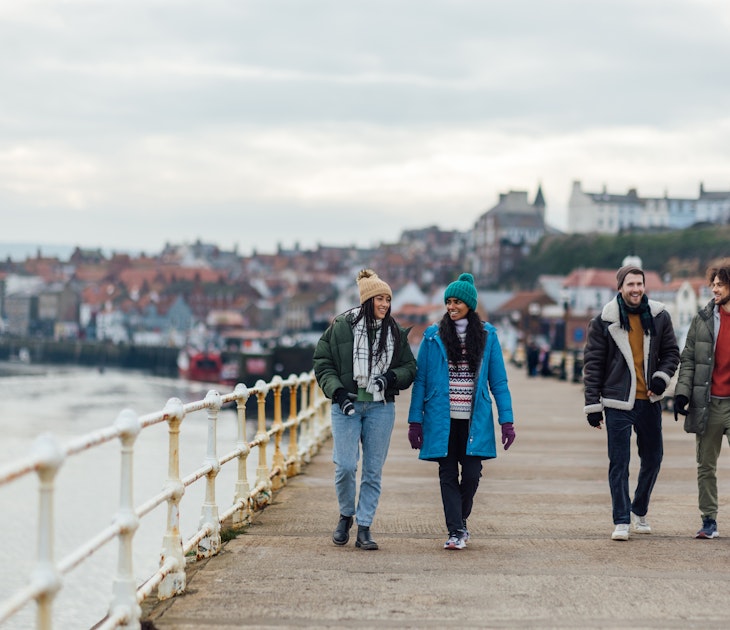
Mar 22, 2024 • 9 min read
Experience the best of England with these top things to do, from city museums to seaside escapes.
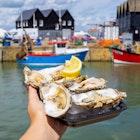
Mar 2, 2024 • 7 min read

Feb 26, 2024 • 10 min read
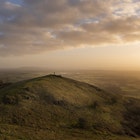
Sep 10, 2023 • 6 min read
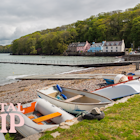
Aug 10, 2023 • 6 min read

Jul 11, 2023 • 8 min read
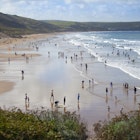
May 15, 2023 • 4 min read

Jul 1, 2022 • 10 min read

Jun 30, 2022 • 10 min read

Jun 1, 2022 • 5 min read

COMMENTS
5. Tintagel Castle. 4,954. Ancient Ruins. Immerse yourself in history, myth and stunning scenery at Tintagel Castle on Cornwall's rugged north coast. Inextricably linked with the legend of King Arthur, for centuries this dramatic castle and coastline has fired the imaginations of writers, artists, and even the brother of a king.